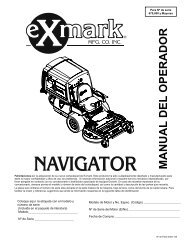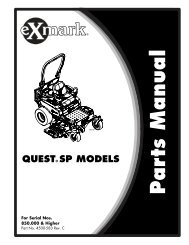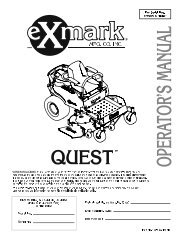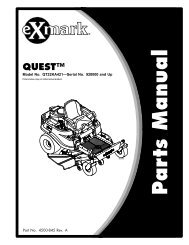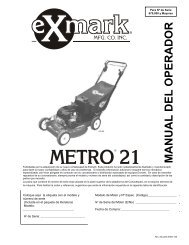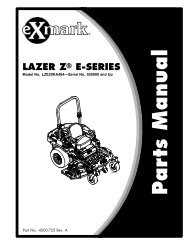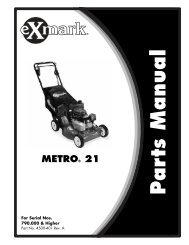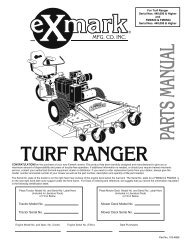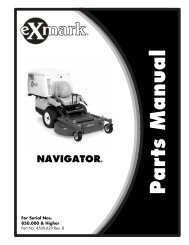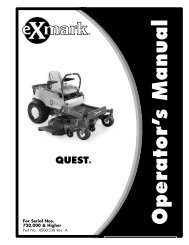MOWING SAFETY TIPS - Exmark
MOWING SAFETY TIPS - Exmark
MOWING SAFETY TIPS - Exmark
- No tags were found...
You also want an ePaper? Increase the reach of your titles
YUMPU automatically turns print PDFs into web optimized ePapers that Google loves.
<strong>MOWING</strong> <strong>SAFETY</strong> <strong>TIPS</strong>Welcome to the <strong>Exmark</strong> familyThank you for choosing an <strong>Exmark</strong>zero-turn mower. These safetyrecommendations are intended foroperator’s of <strong>Exmark</strong>’s consumer mowers.Safety recommendations for <strong>Exmark</strong>commercial mowers can be found atwww.exmark.com/safetytips.htm.With your purchase comes theresponsibility to use your new mowerproperly and safely! This brochure concernsyour safety and the safety of those aroundyou. PLEASE read it carefully!<strong>Exmark</strong> products are built with safety inmind. Our mowers meet or exceed currentindustry and government safety standards;however, their proper use depends onYOU! <strong>Exmark</strong> mowers are designed to cutgrass and they do this to perfection.A lawn mower does notknow the differencebetween a blade ofgrass and a finger or atoe. Most mower-relatedaccidents are caused bynegligent and carelessbehavior. It is up to you, the user, to stayaway from moving parts.REMEMBER:A moment of carelessness could lead to alifetime of regret.Safe Operating Rules for Walk-Behind and Riding MowersThe same caution should be exercisedwhen operating a lawn mower as drivingan automobile. The following rules areintended to help you avoid possibleinjury or even death. Most safe operatinginstructions apply whether you are using ariding mower or a walk-behind mower andshould always be observed.Before performing any service to themower, such as changing the oil orremoving the blade for sharpening, stopthe machine and wait for all moving partsto stop. Always pull the wire off the sparkplug and push it aside so it does notaccidently contact the spark plug. This willensure that the engine does not start.DO NOT alter governor settings. Seeyour <strong>Exmark</strong> dealer if your mower is notperforming properly.Page 1
1. Read the Operator’sManual Thoroughly!Operator’s Manuals address the use andreasonably foreseeable misuse of themower. The manuals are written by <strong>Exmark</strong>employees familiar with the operation ofthe mowers, their capabilities and theirlimitations. Engineers who designed themachines are also involved in the writing ofthe Operator’s Manuals.Keep the Operator’s Manual in a placewhere you can find it when needed.Pay particular attention to the safetyinstructions. Insist that all individuals whowill be operating the mower read andunderstand the Operator’s Manual and thisbrochure at the beginning of each mowingseason.Safety Alert SymbolThis symbol is important toyour personal safety and thesafety of those in the area.When you see it, read theaccompanying message carefully.2. Know How to Stopthe Machine Quickly!Before doing anything else, check theoperation of the blade stopping feature. Ifthe blade stopping feature is not workingproperly, DO NOT operate the moweruntil the problem has been located andcorrected. See your <strong>Exmark</strong> dealer to besure.NEVER leave the operator’s positionwithout firststopping themachine.3. Leave all SafetyFeatures Intact!Guards, shields, deflectors, and warningsdecals are on the machine for yourprotection and that of others.DO NOT remove or disable a safetyfeature because it seems to be aninconvenience. If a safety feature should belost or damaged or a decal should becomeillegible discontinue use of the mower untilthe damaged or missing parts are repairedor replaced.The discharge deflector is designed todirect thrown objects downward into thegrass. They also help prevent accidentalcontact with the blade.DO NOTremove ordisable adeflector,shield, orguard.DO NOToperate themower if thedischarge deflector is in any position otherthan the normal operating position.If the discharge deflector is ever damaged,replace it immediately.NEVER put your hands or feet under themower.NEVER try to clear the discharge area ormower blades unless the engine is stoppedand the spark plug wire has been pulled off.Page 2
Be certain that no persons or pets are inthe vicinity of a mower when it is in use,as a thrown object which hits a sidewalk,driveway, or other hard surface canricochet upward. Stop mowing if a personor foreign object appears in your mowingarea.STOPThis is the only way to avoid possible injuryto that person or damage to objects in thecutting area.DO NOT operate a rear bagger or amower with a mulching attachment unlessthe discharge door is closed, or the bag,mulch plug or side discharge attachment isproperly secured.Check the grass-catching bag frequentlyas it is subject to deterioration. If it is wornor damaged, replace it with a new bag. Ahole or a weak spot in the bag could allowa foreign object to be thrown into theoperator’s position or the surrounding area.If you notice damage to the mower such asloose screws, missing bolts, broken parts,or anything abnormal, STOP the engine,wait for all moving parts to stop, andcorrect the condition before you resumemowing.Check all parts periodically for wear ordeterioration and replace as required withgenuine <strong>Exmark</strong> parts.<strong>Exmark</strong> parts are designed and testedspecifically for use on <strong>Exmark</strong> products. If apart on your mower must be replaced, usea genuine <strong>Exmark</strong> part.4. Clear the Mowing Area!The mower blade rotates at an extremelyhigh speed! It is shaped to create anupward draft under the housing, avacuuming action, to stand the grass upfor a cleaner cut. Because of this, the bladecan pick up debris, such as small rocks,wires, and broken glass, and throw it outthe discharge port with considerable force.The operator should use extreme cautionto minimize the risks from these thrownobjects by taking these precautions.Before startingSTOPthe mower,STOPwalk aroundthe area andpick up anyrocks, wires,sticks, and other objects that the blademight pick up and throw. Be careful aboutthis.REMEMBER once an object has beenthrown and caused injury, it is too late tothink about what should have been done!Keep everyone out of the area beingmowed. If children are playing in the backyard, cut the front yard, and vice versa.Better still, send them into the house whileyou are mowing. A child can dart in frontof the mower in a fraction of a second, andthat’s all it takes for an accident.If someone enters the yard while you’remowing, turn off the mower and wait untilhe or she leaves the area before restartingthe mower.NEVER cross driveways or paths with theblade rotating. The blade can pick up andthrow gravel or loose rocks.Page 3
5. Avoid BladeContactAlways assume theblade is turning whenthe engine is running.NEVER put your handor any part of the body, in or anywhereclose to the blade path when the engine isrunning. This applies even if the mower isequipped with a bladebrake clutch.REMEMBER: Thereis little clearancebetween the outerends of the bladeand the inside surfaceof the housing. An injury can result if theoperator of a lawn mower puts his or herhand in the path of a turning blade whenattempting to clear a plugged dischargeport, or when changing the height-of-cutwithout turning off the engine. To dependentirely on the mechanical or electricalsafely devices is not good enough. Usecaution and common sense as well.NEVER clear the chute with the enginerunning. Turn off the engine and be surethe blade has stopped before making anyadjustments or corrections. Use a stick toclear a plugged discharge area. NEVERuse your hand!6. Never AllowChildren toOperate a LawnMower!A lawn mower is not atoy, and cutting grassis not child’s play.Maturity varies greatlyamong children, buta good rule to follow is: If you’re notcomfortable with them driving yourautomobile, you should not allow themto operate a lawn mower — whether it isa walk behind or riding mower.Only adults and mature teenagers shouldoperate a mower, and even matureteenagers should have adult supervision.Be sure a teenager:1) Has the ability to read and understandthe Operator’s Manual and torecognize the risks involved.2) Is sufficiently mature to use caution.3) Is of sufficient size and weight tooperate the controls comfortably andto manage the mower withouttaking risks.If you have doubts or questions, DONOT take the risk! Make sure allpersons operating the mower read andunderstand the Operator’s Manual firstand are familiar with the controls.7. Wear Appropriate ClothingDress for the job of cutting grass.This means substantial shoes (nosandals, tennis shoes, etc.) and fulllength trousers must be worn. NEVERmow barefooted. Be aware that looseclothing or dangling jewelry can becomeentangled inmoving mowerparts and lead toan accident.To be properlydressed for thejob, gogglesor similar eyeprotection is recommended.Page 4
Riding MowersThe safety instructions above also apply toriding mowers. In addition, the following rulesapply specifically to riding mowers.1. Carry No Passengers!NEVER allow passengers, especially a child onyour lap, on any riding mower, in any cart, oron any implement being towed. This reducesyour ability to control the mower and divertsyour attention fromthe mowing job athand. Remember,there is always a riskthat the child couldslip and fall or jumpoff the mower.2. Use Care During SlopeOperationSlopes are a major factor related to loss ofcontrol and tip-over accidents, which can resultin severe injury or death. Reduce speed anduse extra caution on slopes. If you cannot backup the slope or if you feel uneasy on it, DONOT mow it.NEVER Operate a riding mower on slopesover 15 Degrees. (See page 7 or Operator’sManual for slope chart). Be aware that a lossof traction may occur going downhill. Weighttransfer to the front wheels may cause drivewheels to slip and cause loss of braking andsteering.Do Not mow slopes when grass is wet.Slippery conditions reduce traction and causesliding and loss of control.Use extreme care with grass catchers or otherattachments. These can change the stability ofthe machine and cause loss of control.Caution: If there is any doubtabout tipping or losingcontrol, stay off the slope.To avoid a loss of controland possibility of arollover follow theserecommendations:• Do Not mow neardrop offs or water.• Do Not mowslopes greaterthan 15 degrees.• Reduce speed and use extra caution onslopes.• When mowing slopes, gradually work fromlower to higher areas on the incline.• Avoid sudden turns or rapid speed changes.• Turn up, into an incline when changingdirections on slopes. Turning down theslope reduces traction.• Use a walk-behind mower and/or a trimmernear drop-offs, ditches, steep banks or water.Caution: If there is any doubt about tipping orlosing control, stay off the slope.To avoid a loss of control and possibility of arollover follow these recommendations:• Do Not mow near drop offs or water.• Do Not mow slopes greater than 15 degrees.• Reduce speed and use extra caution onslopes.• When mowing slopes, gradually work fromlower to higher areas on the incline.• Avoid sudden turns or rapid speed changes.• Turn up, into an incline when changingdirections on slopes. Turning down theslope reduces traction.• Use awalk-behindmower and/or a trimmernear dropoffs,ditches,steep banksor water.WATERDANGERZONEGreater than 15°SAFEZONEPage 6It’s up to you, the operator, to anticipate problems and to avoid them!
For more information regarding the safe use of your <strong>Exmark</strong> mower:visit us: www.exmark.comor e-mail: Customer Service — service@exmark.comor write us:<strong>Exmark</strong> Mfg. Inc., Co.2101 Ashland Avenue,P.O. Box 808Beatrice, NE 68310Page 7



